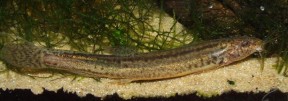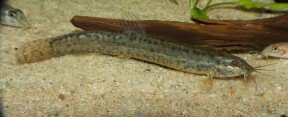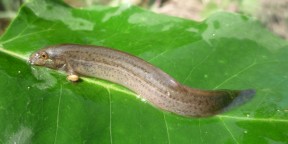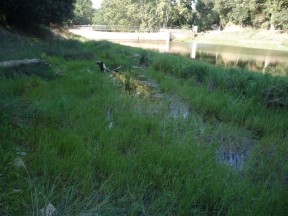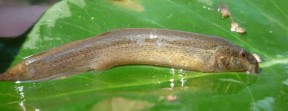Misgurnus dabryanus
Large-scaled Loach
SynonymsTop ↑
Paramisgurnus dabryanus Sauvage, 1878; Misgurnus mizolepis Günther, 1888; Misgurnus oligolepos Chen, Shen & Li, 1994
Classification
Order: Cypriniformes Family: Cobitidae
Distribution
Described from the Yangtze Jiang (Yangtze River) basin in China and currently-accepted to occur throughout middle and lower reaches of both the Yangtze and Zhu Jiang (Pearl River), plus various smaller drainages of Taiwan and the Amur river system which forms the border between far-eastern Russia and northern China along much of its length.
The related, similar-looking Misgurnus anguillicaudatus has been introduced into various countries including Germany, Spain, Italy, Kazakhstan, Uzbekistan, Turkmenistan, the Philippines, U.S.A. (including Hawaii), Canada and Australia and since the two species often occur sympatrically and are sometimes exported in mixed batches the possibility that P. dabryanus has also become established outside its natural range cannot be discounted.
An introduced population was discovered close to Barcelona, Spain in 2008 but apparently has not become established due to rotenone treatment in 2009.
Such introductions are largely attributed to the aquarium fish industry although the use of these loaches as a food fish or live angling bait are also thought to be contributing factors.
Habitat
Most commonly found in shallow, slow-moving sections of rivers and streams or calm habitats such as swamps, oxbows, backwaters and paddy fields.
These are often heavily-vegetated or littered with submerged roots, branches and leaf litter, with substrates composed of soft mud or silt.
Water clarity and depth vary on a seasonal basis across much of its range, and at certain times of year it probably enters temporarily-flooded zones.
Conversely during dry periods some habitats may become stagnant with blooms of macrophytic algae and resultant hypoxia (oxygen depletion).
Under such conditions members of this genus are able to use the posterior portion of the intestine and skin as supplementary breathing organs and often dart to the surface to gulp atmospheric air whilst simultaneously expelling intestinal gases from the vent.
Some species have even been recorded to survive periods in moist sand or mud in the absence of water.
Maximum Standard Length
Officially 90 mm, but may grow larger.
Aquarium SizeTop ↑
An aquarium with a base measuring 90 ∗ 30 cm or more should be considered the minimum requirement.
Maintenance
Must be provided with a soft, sandy substrate since some of its time is spent completely buried. When coarser gravel is used it may become stressed or damage itself trying to dig, and feeding behaviour can be inhibited.
Other décor can include water-worn rocks and driftwood branches or tree roots arranged to form plenty of hiding places and shaded spots – add these prior to the substrate to prevent them being toppled by digging activity.
Lighting can be quite dim unless you intend to grow plants and a few handfuls of leaf litter would complement the natural effect.
High flow rates are best avoided although a degree of oxygenation is recommended. Ensure that small specimens are unable to enter filter intakes and cover the tank well as most loaches do jump at times, especially when first introduced.
Water Conditions
Temperature: 16 – 23 °C
pH: 6.0 – 8.0
Hardness: 18 – 357 ppm
Diet
Chiefly a predator foraging for insect larvae, small crustaceans and suchlike.
In the aquarium it will accept sinking dried foods but should also be offered regular meals of small live and frozen fare such as Daphnia, Artemia, bloodworm, etc. A varied diet is key to maintaining it in the best of health.
Behaviour and CompatibilityTop ↑
This species is generally very peaceful though it may prey on eggs, fry, or very small fishes. It can be kept singly but seems more at ease and active when maintained in a group.
In terms of tankmates it does best alongside medium-to-large sized, active fishes that swim higher up in the water column.
It’s often upsold as a good companion for the ornamental forms of Carassius auratus (goldfish) and while that may be true of comets, shubunkins, etc., it can bother the slower-moving ‘fancy’ types when active, e.g., at feeding times.
Research your choices thoroughly before purchase paying particular attention to adult size and temperature requirements.
Sexual Dimorphism
Adult females are typically heavier-bodied and a little larger then males, while in mature males the pectoral fins are enlarged with thickened rays.
Reproduction
Reports of captive breeding are scarce and we’ve been unable to find one containing any significant detail, though the fish are induced to spawn by means of hormones for scientific research, aquaculture, and presumably the aquarium trade.
The natural process is probably similar to that exhibited by Misgurnus fossilis which, following Kottelat and Freyhof (2007), first spawns at 2-3 years of age and around 110 mm SL during the months of March – July.
The female leads the male into dense vegetation or filamentous algae and as the eggs are released the male wraps his body around that of his mate, forming a complete ring. Post-hatching the fry have external gill filaments which disappear after 10-12 days.
NotesTop ↑
An exceptionally hardy and adaptable species tolerant of a wide range of physiological variables and flexible of diet, factors which have allowed it to become established as an alien species around the globe.
Its high reproductive potential and low vulnerability to predation have made it a cause for concern to conservation scientists although as yet there remains no proof of it exerting a negative effect on native fishes in countries outside its natural range.
It’s actually sold in the aquarium hobby on a regular basis but almost always labelled as or mixed in with Misgurnus anguillicaudatus and is thus poorly documented.
Although quite similar in appearance it can be told apart from M. anguillicaudatus by a number of characters, most notably that it possesses high adipose crests on the caudal peduncle (vs. low adipose crests in M. anguillicaudatus) and lacks a dark spot at the base of the caudal-fin (vs. present).
Both species are heavily utilised for aquaculture projects in China and apparently hybridise in some areas where they occur together.
The family Cobitidae, often referred to as ‘true’ loaches, is widely-distributed across most of Eurasia with the Indian subcontinent, Southeast Asia and China representing particular centres of species diversity.
Recent phylogenetic analyses by Tang et al. (2006), Šlechtová et al. (2007) and Šlechtová et al. (2008) revealed that the group constitutes a separate genetic lineage to the family Botiidae (the two were previously grouped together under Cobitidae as subfamilies Cobitinae and Botiinae).
Misgurnus is included in one of four generalised lineages within a ‘northern’ clade of the family Cobitidae comprising species distributed in Europe, western, northern and eastern Asia, Vietnam and Laos. These are as follows:
1) All species of Sabanjewia.
2) Microcobitis misgurnoides.
3) All Misgurnus and Koreocobitis spp.
4) All Cobitis spp. plus Iksookimia, Niwaëlla and Kichulchoia spp.
All cobitids possess sharp, motile, sub-ocular spines which are normally concealed within a pouch of skin but erected when an individual is stressed e.g. if removed from the water. Care is therefore necessary as these can become entangled in aquarium nets and with larger species even break human skin.
References
- Kottelat, M., 2012 - Raffles Bulletin of Zoology Supplement 26: 1-199
Conspectus cobitidum: an inventory of the loaches of the world (Teleostei: Cypriniformes: Cobitoidei). - Kottelat, M., 2001 - Environment and Social Development Unit, East Asia and Pacific Region. The World Bank.: i-iii + 1-123
Freshwater fishes of northern Vietnam. A preliminary check-list of the fishes known or expected to occur in northern Vietnam with comments on systematics and nomenclature. - Kottelat, M. and J. Freyhof, 2007 - Kottelat, Cornol, Switzerland and Freyhof, Berlin, Germany. Publications Kottelat: xiii+ 1-646
Handbook of European Freshwater Fishes. - Tang, Q., H. Liu, R. Mayden and B. Xiong, 2006 - Molecular Phylogenetics and Evolution 39(2): 347-357
Comparison of evolutionary rates in the mitochondrial DNA cytochrome b gene and control region and their implications for phylogeny of the Cobitoidea (Teleostei: Cypriniformes). - You, C., X. Yu and J. Tong, 2007 - Environmental Biology of Fishes 86(1): 65-71
Detection of hybridization between two loach species (Paramisgurnus dabryanus and Misgurnus anguillicaudatus) in wild populations - Šlechtová, V., J. Bohlen and A. Perdices, 2008 - Molecular Phylogenetics and Evolution 47(2): 812-831
Molecular phylogeny of the freshwater fish family Cobitidae (Cypriniformes: Teleostei): delimitation of genera, mitochondrial introgression and evolution of sexual dimorphism. - Šlechtová, V., J. Bohlen and H. H. Tan, 2007 - Molecular Phylogenetics and Evolution 44(3): 1358-1365
Families of Cobitoidea (Teleostei; Cypriniformes) as revealed from nuclear genetic data and the position of the mysterious genera Barbucca, Psilorhynchus, Serpenticobitis and Vaillantella.
